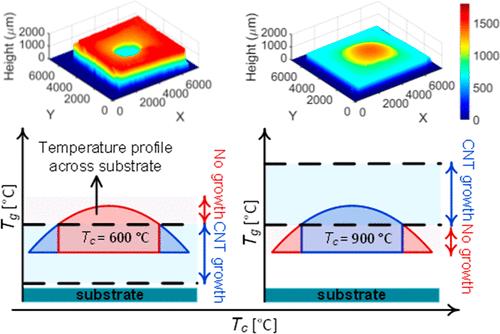Improving Geometric Uniformity in Dynamic Chemical Vapor Deposition of Carbon Nanotube Forests
IF 3.9
3区 工程技术
Q2 ENGINEERING, CHEMICAL
引用次数: 0
Abstract
Geometric nonuniformities are often observed in the catalytic chemical vapor deposition (CVD) of vertically aligned carbon nanotubes (VACNTs), known as CNT forests. These nonuniformities typically occur in the form of sloped heights and empty regions within the catalyst-covered substrate. To realize the true potential of carbon nanotube forests in unidirectional mass and energy transport applications, it is critical to develop robust manufacturing processes to produce geometrically uniform CNT forests on large-scale substrates in a repeatable manner. Our custom-designed reactor with an IR heating multizone furnace with rapid thermal processing capability allows the programming of dynamic recipes with the catalyst formation temperature decoupled from the CNT nucleation and growth temperature. In this work, we present an approach for tuning the geometric uniformity of CNT forests based on the combined effects of substrate holder design and dynamic recipes during CVD. We propose a mechanism that explains the observed geometric nonuniformities based on both the temperature profile across the catalyst chip, which depends on the substrate holder design, and the temperature range for CNT growth, which depends on the catalyst formation temperature. We performed a comparative study of the properties of alumina layers after annealing with two different substrate holder designs. We found that the actual temperature experienced by the sample depends on the substrate holder, which supports our proposed mechanism. Our work provides insight into the growth of CNT forests with large-scale spatial uniformity and high structural quality.

提高碳纳米管森林动态化学气相沉积的几何均匀性
垂直排列的碳纳米管(VACNTs)被称为碳纳米管森林,在催化化学气相沉积(CVD)中经常观察到几何不均匀性。这些不均匀性通常以倾斜高度和在催化剂覆盖的底物内的空区域的形式出现。为了实现碳纳米管森林在单向质量和能量传输应用中的真正潜力,关键是要开发强大的制造工艺,以可重复的方式在大规模基板上生产几何均匀的碳纳米管森林。我们定制设计的反应器配有红外加热多区炉,具有快速热加工能力,可以在催化剂形成温度与碳纳米管成核和生长温度脱钩的情况下,对动态配方进行编程。在这项工作中,我们提出了一种基于衬底支架设计和CVD过程中动态配方的综合效应来调整碳纳米管森林几何均匀性的方法。我们提出了一种机制来解释观察到的几何不均匀性,该机制基于催化剂芯片上的温度分布(取决于衬底支架设计)和碳纳米管生长的温度范围(取决于催化剂形成温度)。我们用两种不同的衬底支架设计对氧化铝层退火后的性能进行了比较研究。我们发现样品所经历的实际温度取决于衬底支架,这支持了我们提出的机制。我们的工作为大规模空间均匀性和高结构质量的碳纳米管森林的生长提供了见解。
本文章由计算机程序翻译,如有差异,请以英文原文为准。
求助全文
约1分钟内获得全文
求助全文
来源期刊

Industrial & Engineering Chemistry Research
工程技术-工程:化工
CiteScore
7.40
自引率
7.10%
发文量
1467
审稿时长
2.8 months
期刊介绍:
ndustrial & Engineering Chemistry, with variations in title and format, has been published since 1909 by the American Chemical Society. Industrial & Engineering Chemistry Research is a weekly publication that reports industrial and academic research in the broad fields of applied chemistry and chemical engineering with special focus on fundamentals, processes, and products.
 求助内容:
求助内容: 应助结果提醒方式:
应助结果提醒方式:


